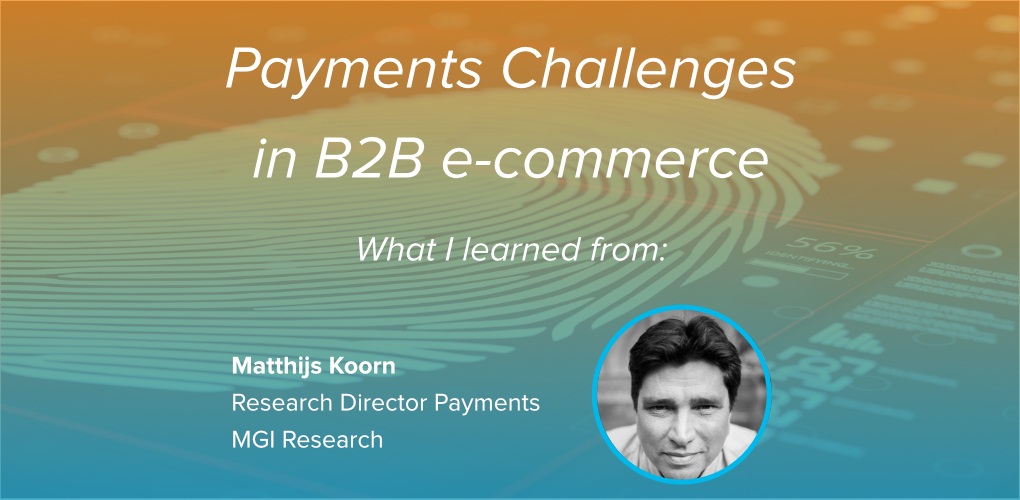
Insights & Opinions
Payments Challenges in B2B e-commerce
Tue, 23 Nov 2021


Suddenly e-commerce became an entirely new world to me.
Last week’s Afterwork session (November 18, 2021) was all about the payments challenges in B2B e-commerce, for which we invited Matthijs Koorn, Research Director Payments at MGI Research.
I admit that we should have had this session much earlier, and I am not just saying that because 50% of the audience said so in the poll.
Did you know that the B2B e-commerce is a $120 trillion business opportunity, double the size of the B2C market? Matthijs specified that this is only the buying side.
Why B2B e-commerce is an entirely different beast
This market has many players, going from independent entrepreneurs to government institutions, all with their different buying patterns and financial priorities in the buying process.
Matthijs: “All these companies buy differently. In small companies up to the midsize company, you will see a strong B2C type behaviour. On the other hand, enterprises have a lot of processes and software in place. These larger companies have very organised processes and procedures. They will run an RFP (Request for Proposal) or an RFI (Request for Information), or there will be a procure to pay process.”
A lot of B2B purchasing is not standardised and as a B2B e-commerce business that can be challenging. Big corporates, for example, can negotiate better payment terms with their suppliers. How do you deal with these differences in an e-commerce context?
Did you know, by the way, that only 2% of this $120 trillion business opportunity is don by cards? All the rest is paid with cash, credit transfer, wire transfer… explained Matthijs. Although you will read later in the blog that this is about to change.
B2B subscription economy
“Products are dead, and everything is becoming a service”, explained Matthijs. “It started with Spotify and Netflix, who are very consumer-driven, but now you see a lot of, I’m going to call it, products that in effect have become a service being priced on a sort of outcome-based pricing.”
He shared two examples to make his point. The first one is GE, which has a business unit for aeroplane engines. Thanks to the Internet of Things, they can now leave the customer to buy the engine or pay for usage.
Caterpillar is another very speaking example: they leave the customer the choice to buy mining equipment or let Caterpillar operate the mine for you, and you pay for the outcome of the mine. You pay for the value as a result of using the equipment.
The trade-off for many organisations here is whether it wishes to affect its CAPEX or OPEX. In other words: these e-commerce decisions are often very strategic.
Obviously, cards are not the most suitable payment method for these subscriptions.
The value of virtual cards in B2B e-commerce
Not every subscription in B2B deals with heavy machinery. Much attention during our session went into the value of virtual cards as a way to better manage corporate subscriptions and other expenses.
The most common examples where virtual cards add tremendous value is in better user management of cloud-based software, or expense management for travel.
Matthijs explained: “In a way, virtual cards work like a normal credit card, but they’re typically issued for single-use, and you can give them certain additional parameters, like the spending amount, the validity, at which merchant can you use them, you can either set the hours that they can be used at, for instance, only during the day. And as I said, single-use, so if they are used once, they no longer exist.”
This ecological solution has no plastic involved. Issuing a virtual card will typically release an email with a PIN code, card number, expiry date and a CVC code. Would you need a payment means for POS (point of sale), you can often upload the card details in ApplePay, GooglePay or another mobile wallet.
Matthijs: “Every virtual card can hold up to 25-26 additional data fields. That could be the employee number or the cost centre of the employee. If there was a purchase order involved, it could be the purchase order number, or the approver’s name, to name a few. So the reconciliation, as a result, is also a lot better.”
Instead of setting up a procedure-driven travel policy, companies can now allocate budgets through virtual cards and empower employees to manage their travel budgets better. The spending with a virtual card often allows more accurate data than the traditional CRM, allowing the company to negotiate better deals.
Take virtual cards to manage and pay for social media campaigns for digital agencies as another example. Having a virtual card with a client number or client purchase order will ease the reconciliation. “Plus, if it’s a credit card that runs on a credit line, the campaign will have been paid by their clients before they need to settle the credit card bill”, added Matthijs.
How about chargeback risk? Because the limited freedom to use the card, fraud levels are near zero. Matthijs added: “Many of the virtual card setups are particularly in accounts payable, and we’re talking about very specifically payable accounts here. There is often an underlying contract that will rule out any chargebacks because the card is specifically issued against that seller.”
Isn’t the 3% interchange a show stopper? “For high amounts, companies can run it on a P-card (Procurement Card), which will give you already a lower interchange. From the top of my head, I think it’s a fixed fee of like 40 or 50 euros or pounds per transaction and then an interchange on activities below 1%,”, added Matthijs.
Looking forward
We also discussed the most exciting developments for the future of B2B e-commerce. Much emphasis was put on risk management through enhanced data sharing opportunities. We had an open discussion with the audience, looking at what open banking and PSD2 can do in bringing together more information.
By linking this to data sources like Graydon or Moody’s, banks and corporates can better estimate merchants' risk, leading to more bargaining power and a reduced risk in e-commerce.
Cross-border e-commerce still moves many letters of credit, and Matthijs believes that SWIFT will continue to dominate this space, especially given SWIFT’s new platform approach.
Unlike SWIFT, Matthijs does believe that banks are no longer in a leading role when it comes to serving their customer’s B2B e-commerce needs.
“It’s moving too fast for a bank to keep up. There is a nice slide, I think it’s from ING, with a couple of greyhounds running, and ING is pictured as a big elephant trying to keep up”, Matthijs explained. “I think that summarises it very well what they’re trying to do, but an elephant cannot keep up. I think banks should focus on what they are good at. We touched on risk management.”
“They have life clients. They have a relationship at C-level, they have money, they have access to money, there is a lot of individual knowledge and expertise in the bank. So for banks, the way to go this is partnering, whether that’s partnering or joint venturing, using the technology and then using the bank’s money. To build the IT themselves and try to enter the market now, is too late in my opinion. And it’s risky.”